- Home
- Robert A. Heinlein
The Pursuit of the Pankera: A Parallel Novel About Parallel Universes Page 6
The Pursuit of the Pankera: A Parallel Novel About Parallel Universes Read online
Page 6
But we wasted (“wasted?”) a few moments because everybody had to kiss everybody else—even Zebbie and my husband pounded each other on the back and kissed both cheeks Latin-style.
Class resumed. “Sharpie, can you explain precession in gyroscopes?”
“Well, maybe. Physics One was required but that was a long time ago. Push a gyroscope and it doesn’t go the way you expect, but ninety degrees from that direction so that the push lines up with the spin. Like this—” I pointed a forefinger like a little boy going: Bang! You’re dead! “My thumb is the axis, my forefinger represents the push, the other fingers show the rotation.”
“Go to the head of the class. Now—think hard!—suppose we put a gyroscope in a frame, then impress equal forces at all three spatial coordinates at once; what would it do?”
I tried to visualize it. “I think it would either faint or drop dead.”
“A good first hypothesis. According to Jake, it disappears.”
“They do disappear, Aunt Hilda. I watched it happen several times.”
“But where do they go?”
“I can’t follow Jake’s math; I have to accept his transformations without proof. But it is based on the notion of six space-time coordinates, three of space, the usual three that we see—marked x, y, and z—and three time coordinates: one marked ‘t’ like this—” (t) “—and one marked ‘tau,’ Greek alphabet—” (τ) “—and the third from the Cyrillic alphabet, ‘teh’—” (Т ).
“Looks like an ‘M’ with a macron over it.”
“So it does, but it’s what the Russians use for ‘T.’ ”
“No, the Russians use ‘chai’ for tea. In thick glasses with strawberry jam.”
“Stow it, Sharpie. So we have x, y, and z; t, tau, and teh, six dimensions. It is basic to the theory that all are at right angles to each other, and that any one may be swapped for any of the others by rotation—or that a new coordinate may be found (not a seventh but replacing any of the six) by translation—say ‘tau’ to ‘tau prime’ by displacement along ‘x.’ ”
“Zebbie, I think I fell off about four coordinates back.”
My husband suggested, “Show her the caltrop, Zeb.”
“Good idea.” Zeb accepted a widget from my husband, placed it in front of me. It looked like jacks I used to play with as a little girl but not enough things sticking out: four instead of six. Three touched the table, a tripod; the fourth stuck straight up.
Zeb said, “This is a weapon, invented centuries ago. The points should be sharp but these have been filed down.” He flipped it, let it fall to the table. “No matter how it falls, one prong is vertical. Scatter them in front of cavalry; the horses go down—discouraging. They came into use again in Wars One and Two against anything with pneumatic tires—bicycles, motorcycles, lorries, and so forth. Big enough, they disable tanks and tracked vehicles. A small sort can be whittled from thorn bushes for guerrilla warfare—usually poisoned and quite nasty.
“But here this lethal toy is a geometrical projection, a drawing of the coordinates of a four-dimensional space-time continuum. Each spike is exactly ninety degrees from every other spike.”
“But they aren’t,” I objected. “Each angle is more than a right angle.”
“I said it was a projection. Sharpie, it’s an isometric projection of four-dimensional coordinates in three-dimensional space. That distorts the angles … and the human eye is even more limited. Cover one eye and hold still and you see only two dimensions. The illusion of depth is a construct of the brain.”
“I’m not very good at holding still—”
“No, she isn’t,” agreed my bridegroom, whom I loved dearly and at that instant could have choked.
“But I can close both eyes and feel three dimensions with my hands.”
“A good point. Close your eyes and pick this up and think of the prongs as the four directions of a four-dimensional space. Does the word tesseract mean anything to you?”
“My high school geometry teacher showed us how to construct them—projections—with modeling wax and toothpicks. Fun. I found other four-dimensional figures that were easy to project. And a number of ways to project them.”
“Sharpie, you must have had an exceptional geometry teacher.”
“In an exceptional geometry class. Don’t faint, Zebbie, but I was grouped with what they called ‘overachievers’ after it became ‘undemocratic’ to call them ‘gifted children.’ ”
“Be durned! Why do you always behave like a fritterhead?”
“Why don’t you ever look beneath the surface, young man? I laugh because I dare not cry. This is a crazy world and the only way to enjoy it is to treat it as a joke. That doesn’t mean I don’t read and can’t think. I read everything from Giblett to Hoyle, from Sartre to Pauling. I read in the tub, I read on the john, I read in bed, I read when I eat alone, and I would read in my sleep if I could keep my eyes open.”
“OK. I apologize. Professor, we can speed up this seminar; we’ve been underrating our overachiever. Hilda is a brain.”
“Zebbie, can we kiss and make up?”
“Class is in session.”
“Zebadiah, there is always time for that. Right, Pop?”
“Kiss her, son, or she’ll sulk.”
“I don’t sulk, I bite.”
“I think you’re cute, too,” Zebbie answered, grabbed me by both shoulders, dragged me over the table, and kissed me hard.
He dropped me abruptly and said, “Attention, class. The two prongs of the caltrop painted blue represent our three-dimensional space of experience. The third prong painted yellow is the t-time we are used to. The red fourth prong simulates both tau-time and teh-time, the unexplored time dimensions necessary to Jake’s theory. Sharpie, we have condensed six dimensions into four, then we either work by analogy into six, or we have to use math that apparently nobody but Jake and my cousin Ed understands. Unless you can think of some way to project six dimensions into three—you seem to be smart at such projections.”
I closed my eyes and thought hard. “Zebbie, I don’t think it can be done. Maybe Escher could have done it.”
“It can be done, my dearest,” answered my dearest, “but it is unsatisfactory. Even with a display computer with capacity to subtract one or more dimensions at a time. A superhypertesseract—a to the sixth power—has too many lines and corners and planes and solids and hypersolids for the eye to grasp. Cause the computer to subtract dimensions and what you have left is what you already knew. I fear it is an innate incapacity of visual conception in the human brain.”
“I think Pop is right,” agreed Deety. “I worked hard on that program. I don’t think the late, great Dr. Marvin Minsky could have done it better in flat projection. Holovision? I don’t know. I would like to try if I ever get my hands on a computer with holovideo display and the capacity to add, subtract, and rotate six coordinates.”
“But why six dimensions?” I asked. “Why not five? Or even four, since you speak of rotating them interchangeably.”
“Jake?” asked Zeb.
My darling looked fussed. “It bothered me that a space-time continuum seemed to require three space dimensions but only one time dimension. Granted that the universe is what it is, nevertheless nature is filled with symmetries. Even after the destruction of the parity principle, scientists kept finding new ones. Philosophers stay wedded to symmetry—but I don’t count philosophers.”
“Of course not,” agreed Zeb. “No philosopher allows his opinions to be swayed by facts—he would be kicked out of his guild. Theologians, the lot of them.”
“I concur. Hilda, my darling, after I found a way to experiment, it turned out that six dimensions existed. Possibly more—but I see no way to reach them.”
“Let me see,” I said. “If I understood earlier, each dimension can be swapped for any other.”
“By ninety-degree rotation, yes.”
“Wouldn’t that be the combinations taken four at a time out of a set of six? How m
any is that?”
“Fifteen,” Zebbie answered.
“Goodness! Fifteen whole universes? And we use only one?”
“No, no, my darling! That would be ninety-degree rotations of one Euclidean universe. But our universe, or universes, has been known to be non-Euclidean at least since 1919. Or 1886, if you prefer. I stipulate that cosmology is an imperfect discipline; nevertheless, for considerations that I cannot state in nonmathematical terms, I was forced to assume a curved space of positive radius—that is to say, a closed space. That makes the universes possibly accessible to use, either by rotation or by translation, this number.” My husband rapidly wrote three sixes.
“Six sixty-six,” I said wonderingly. “The Number of the Beast.”
“Eh? Oh! The Revelation of Saint John the Divine. But I scrawled it sloppily. You took it that I wrote this: ‘666.’ But what I intended to write was this: ‘((6)6 )6.’ Six raised to its sixth power, and the result in turn raised to its sixth power. That number is this: 1.03144+ × 1028—or written in full, 10,314,424,798,490,535,546,171,949,056—or more than ten million sextillion universes in our group.”
What can one say to that? Jacob went on, “Those universes are our next-door neighbors, one rotation or one translation away. But if one includes combinations of rotation and translation—think of a hyperplane slicing through superhypercontinua not at the point of here—now—the total becomes indenumerable. Not infinity—infinity has no meaning. Uncountable. Not subject to manipulation by mathematics thus far invented. Accessible to continua craft but no known way to count them.”
“Pop—”
“Yes, Deety?”
“Maybe Aunt Hilda hit on something. Agnostic as you are, you nevertheless keep the Bible around as history and poetry and myth.”
“Who said I was agnostic, my daughter?”
“Sorry, sir. I long ago reached that conclusion because you won’t talk about it. Wrong of me. Lack of data never justifies a conclusion. But this key number—one-point-oh-three-one-four-four-plus times ten to its twenty-eighth power—perhaps that is the ‘Number of the Beast.’ ”
“What do you mean, Deety?”
“That Revelation isn’t history, it’s not good poetry, and it’s not myth. There must have been some reason for a large number of learned men to include it—while chucking out several dozen gospels. Why not make a first hypothesis with Occam’s Razor and read it as what it purports to be? Prophecy.”
“Hmm. The shelves under the stairs, next to Shakespeare. The King James version, never mind the other three.”
Deety was back in a moment with a well-worn black book—which surprised me. I read the Bible for my own reasons but it never occurred to me that Jacob would. We always marry strangers.
“Here,” said Deety. “Chapter thirteen, verse eighteen. ‘Here is wisdom. Let him that hath understanding count the number of the beast: for it is the number of a man; and his number is Six hundred threescore and six.’ ”
“That can’t be read as exponents, Deety.”
“But this is a translation, Pop. Wasn’t the original in Greek? I don’t remember when exponents were invented but the Greek mathematicians of that time certainly understood powers. Suppose the original read ‘Zeta, Zeta, Zeta!’—and those scholars, who weren’t mathematicians, mistranslated it as six hundred and sixty-six?”
“Uh … moondrift, daughter.”
“Who taught me that the world is not only stranger than we imagine but stranger than we can imagine? Who has already taken me into two universes that are not this one … and brought me safely home?”
“Wait a half!” Zebbie said. “You and Pop have already tried the time-space machine?”
“Didn’t Pop tell you? We made one minimum translation. We didn’t seem to have gone anywhere and Pop thought he had failed. Until I tried to look up a number in the phone book. No ‘J’ in the book. No ‘J’ in the Britannica. No ‘J’ in any dictionary. So we popped back in, and Pop returned the verniers to zero, and we got out, and the alphabet was back the way it ought to be and I stopped shaking. But our rotation was even more scary and we almost died. Out in space with blazing stars—but air was leaking out and Pop just barely put it back to zero before we passed out … and came to, back here in Snug Harbor.”
“Jake,” Zebbie said seriously, “that gadget has got to have more fail-safes, in series with deadman switches for homing.” He frowned. “I’m going to keep my eye open for both numbers, six sixty-six and the long one. I trust Deety’s hunches. Deety, where is the verse with the description of the Beast? It’s somewhere in the middle of the chapter.”
“Here. ‘And I beheld another beast coming up out of the earth; and he had two horns like a lamb, and he spake as a dragon.’ ”
“Hmm—I don’t know how dragons speak. But if something comes up out of the earth and has two horns … and I see or hear either number—I’m going to assume that he has a ‘Black Hat’ and try to do unto him before he does unto us. Deety, I’m peaceable by policy … but two near misses is too many. Next time I shoot first.”
I would as lief Zebbie hadn’t mentioned “Black Hats.” Hard to believe that someone was trying to kill anyone as sweet and innocent and harmless as my darling Jacob. But they were—and we knew it.
I asked, “Where is this time machine? All I’ve seen is a claptrap.”
“ ‘Caltrop,’ Aunt Hilda. You’re looking at the space-time machine.”
“Huh? Where? Why aren’t we in it and going somewhere fast? I don’t want my husband killed; he’s practically brand new. I expect to get years of wear out of him.”
“Sharpie, stop the chatter,” Zebbie put in. “It’s on that bench, across the table from you.”
“All I see is a portable sewing machine.”
“That’s it.”
“What? How do you get inside? Or do you ride it like a broom?”
“Neither. You mount it rigidly in a vehicle—one airtight and watertight by strong preference. Pop had it mounted in his car—not quite airtight and now kaput. Pop and I are going to mount it in Gay Deceiver, which is airtight. With better fail-safes.”
“Much better fail-safes, Zebbie,” I agreed.
“They will be. I find that being married makes a difference. I used to worry about my own skin. Now I’m worried about Deety’s. And yours. And Pop’s. All four of us.”
“Hear, hear!” I agreed. “All for one, and one for all!”
“Yup,” Zebbie answered. “Us four, no more. Deety, when’s lunch?”
VII
Deety
While Aunt Hilda and I assembled lunch, our men disappeared. They returned just in time to sit down. Zebadiah carried an intercom unit; Pop had a wire that he plugged in to a jack in the wall, then hooked to the intercom.
“Gentlemen, your timing is perfect; the work is all done,” Aunt Hilda greeted them. “What is that?”
“A guest for lunch, my dearest,” Pop answered. “Miss Gay Deceiver.”
“Plenty for all,” Aunt Hilda agreed. “I’ll set another place.” She did so; Zebadiah put the intercom on the fifth plate. “Does she take coffee or tea?”
“She’s not programmed for either, Hilda,” Zebadiah answered, “but I thank you on her behalf. Ladies, I got itchy about news from Singapore and Sumatra. So I asked my autopilot to report. Jake came along, then pointed out that he had spare cold circuits here and there, just in case—and this was a just-in-case. Gay is plugged to the garage end of that jack, and this is a voice-switched master-master intercom at this end. I can call Gay and she can call me if anything new comes in—and I increased her programming by reinstating the earlier programs, Logan and back home, for running retrieval of new data.”
“I’ll add an outlet in the basement,” agreed Pop. “But, son, this is your home—not California.”
“Well—”
“Don’t fight it, Zebbie. This is my home since Jacob legalized me … and any step-son-in-law of mine is at home here; you heard Jacob say so.
Right, Deety?”
“Of course,” I agreed. “Aunt Hilda is housewife and I’m scullery maid. But Snug Harbor is my home, too, until Pop and Aunt Hilda kick me out into the snow—and that includes my husband.”
“Not into snow, Deety,” Aunt Hilda corrected me. “Jacob would insist on a sunny day; he’s kind and gentle. But that would not leave you with no roof over your head. My California home—mine and Jacob’s—has long been your home-from-home, and Zebbie has been dropping in for years, whenever he was hungry.”
“I had better put my bachelor flat into the pot.”
“Zebbie, you can’t put Deety on your daybed. It’s lumpy, Deety. Broken springs. Bruises. Zebbie, break your lease and send your furniture back to Goodwill.”
“Sharpie, you’re at it again. Deety, there is no daybed in my digs. An emperor-size bed big enough for three—six if they are well acquainted …. Pop, Snug Harbor continues to impress me. Did you use an architect?”
“Hrrumph! ‘Architect’ is a dirty word. I studied engineering. Architects copy each other’s mistakes and call it ‘Art.’ Even Frank Lloyd Wright never understood what the Gilbreths were doing. His houses looked great from the outside—inside they were hideously inefficient. Dust collectors. Gloomy. Psych lab rat mazes. Pfui!”
“How about Neutra?”
“If he hadn’t been hamstrung by building codes and union rules and zoning laws, Neutra could have been great. But people don’t want efficient machines for living; they prefer to crouch in medieval hovels, as their flea-bitten forebears did. Cold, drafty, unsanitary, poor lighting, and no need for any of it.”
“I respect your opinion, sir. Pop—three fireplaces … no chimneys. How? Why?”
“Zeb, I like fireplaces—and a few cords of wood can save your life in the mountains. But I see no reason to warm the outdoors or to call attention to the fact that we are in residence or to place trust in spark arresters in forest-fire country. Lighting a fire in a fireplace here automatically starts its exhaust fan. Smoke and particles are electrostatically precipitated. The precipitators are autoscrubbed when stack temperature passes twenty-five Celsius, dropping. Hot air goes through labyrinths under bathtubs and floors, then under other floors, thence into a rock heat-sink under the garage, a sink that drives the heat pump that serves the house. When flue gas finally escapes, at points distant from the house, it is so close to ambient temperature that only the most sensitive heat-seeker could sniff it. Thermal efficiency plus the security of being inconspicuous.”

 Job: A Comedy of Justice
Job: A Comedy of Justice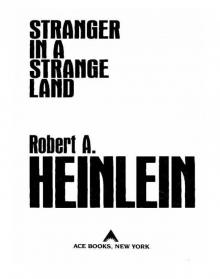 Stranger in a Strange Land
Stranger in a Strange Land The Worlds Of Robert A Heinlein
The Worlds Of Robert A Heinlein The Roads Must Roll
The Roads Must Roll Starship Troopers
Starship Troopers Farmer in the Sky
Farmer in the Sky The Past Through Tomorrow
The Past Through Tomorrow The Door Into Summer
The Door Into Summer All You Zombies
All You Zombies Friday
Friday Tomorrow, the Stars
Tomorrow, the Stars The Notebooks of Lazarus Long
The Notebooks of Lazarus Long The Moon Is a Harsh Mistress
The Moon Is a Harsh Mistress Beyond This Horizon
Beyond This Horizon Time Enough for Love
Time Enough for Love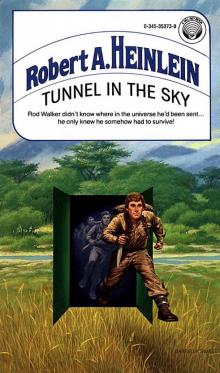 Tunnel in the Sky
Tunnel in the Sky Podkayne of Mars
Podkayne of Mars The Star Beast
The Star Beast The Cat Who Walks Through Walls
The Cat Who Walks Through Walls Grumbles From the Grave
Grumbles From the Grave Time for the Stars
Time for the Stars The Number of the Beast
The Number of the Beast The Unpleasant Profession of Jonathan Hoag
The Unpleasant Profession of Jonathan Hoag Sixth Column
Sixth Column To Sail Beyond the Sunset
To Sail Beyond the Sunset Revolt in 2100
Revolt in 2100 And He Built a Crooked House
And He Built a Crooked House The Pursuit of the Pankera: A Parallel Novel About Parallel Universes
The Pursuit of the Pankera: A Parallel Novel About Parallel Universes Expanded Universe
Expanded Universe Starman Jones
Starman Jones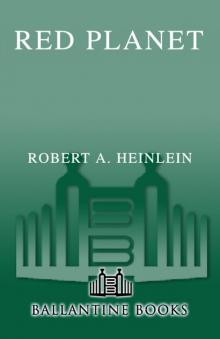 Red Planet
Red Planet Double Star
Double Star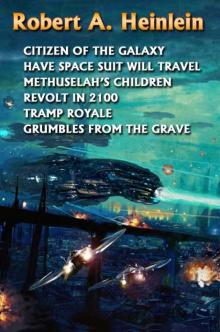 Citizen of the Galaxy
Citizen of the Galaxy Rocket Ship Galileo
Rocket Ship Galileo Glory Road
Glory Road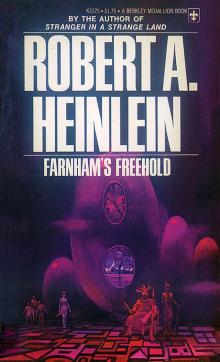 Farnham's Freehold
Farnham's Freehold Space Cadet
Space Cadet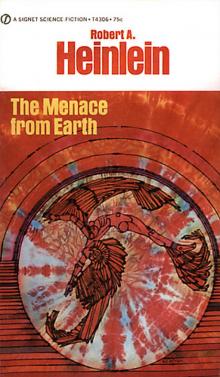 The Menace From Earth ssc
The Menace From Earth ssc Between Planets
Between Planets Methuselah's Children
Methuselah's Children Have Space Suit—Will Travel
Have Space Suit—Will Travel The Rolling Stones
The Rolling Stones Door Into Summer
Door Into Summer The Cat Who Walked Through Walls
The Cat Who Walked Through Walls Magic, Inc
Magic, Inc Off The Main Sequence
Off The Main Sequence Pied Piper
Pied Piper The Unpleasant Profession Of Jonathan Hoag And Other Stories
The Unpleasant Profession Of Jonathan Hoag And Other Stories Variable Star
Variable Star Waldo, and Magic, Inc
Waldo, and Magic, Inc Robert A. Heinlein: In Dialogue With His Century
Robert A. Heinlein: In Dialogue With His Century Waldo
Waldo Bulletin Board
Bulletin Board Job: A Comedy
Job: A Comedy Tramp Royale
Tramp Royale A Tenderfoot in Space
A Tenderfoot in Space For Us, the Living
For Us, the Living Destination Moon
Destination Moon Logic of Empire
Logic of Empire The Fantasies of Robert A. Heinlein
The Fantasies of Robert A. Heinlein The Menace From Earth
The Menace From Earth From the Notebooks Of Lazarus Long
From the Notebooks Of Lazarus Long Have Space Suit - Will Travel
Have Space Suit - Will Travel A Stranger in a Strange Land
A Stranger in a Strange Land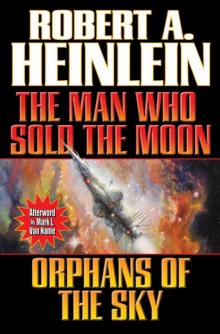 Man Who Sold the Moon / Orphans of the Sky
Man Who Sold the Moon / Orphans of the Sky